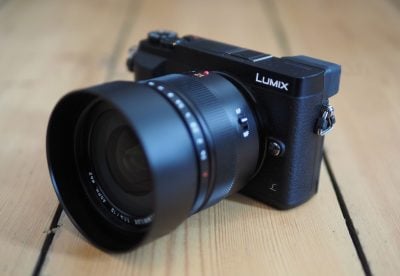Leica DG 12mm f1.4 review
-
-
Written by Gordon Laing
In depth
The Leica Summilux 12mm f1.4 is a wide-angle prime lens designed for the Micro Four Thirds system. Mounted on a Panasonic or Olympus body, it delivers equivalent coverage of 24mm giving you a comfortably broader field-of-view than a standard 28mm without the extreme nature of ultra-wides. Meanwhile the bright f1.4 focal ratio allows you to maintain lower sensitivities or handholdable shutter speeds in low light, while also providing better opportunities for shallow depth-of-field effects than rivals of the same focal length in the Micro Four Thirds catalogue.
Announced in June 2016, the Leica 12mm f1.4 becomes the sixth Micro Four Thirds lens designed and manufactured as a joint effort between Leica and Panasonic. It follows the early 45mm f2.8 Macro and 25mm f1.4, along with the more recent 42.5mm f1.2 Nocticron, 15mm f1.7 and 100-400mm f4-6.3. Like those models, the 12mm f1.4 is designed and certified by Leica in Germany, and manufactured by Panasonic in Japan. As such it may not be ‘pure’ Leica, but the optical and build quality is of a very high standard.
As the most established of the mirrorless systems, Micro Four Thirds typically offers competition at each popular focal length and 12mm is no different. Most obviously Olympus has long offered a 12mm f2 prime lens, and the focal length is also featured in several zooms including the Lumix G 7-14mm f4 and Olympus 7-14mm f2.8, not to mention a number of kit zooms starting at this point. As a higher-end option, the Leica 12mm Summilux is directly targeting the Olympus 12mm f2 prime and Olympus 7-14mm f2.8 zoom, so in my review I’ve made extensive comparisons between the three models to help you decide! I’ll start with a video overview of the lens.
Leica Summilux 12mm f1.4 design and build quality
The Leica Summilux 12mm f1.4 shares a family resemblance with the earlier Panasonic / Leica collaborations with a smart-looking design, higher gloss finish and distinctive Leica font for labeling. Measuring 70mm in diameter (62mm filter thread) and 70mm in length, and weighing 335g, it’s one of the larger primes for the system and is only a little smaller than the Nocticron 42.5mm f1.2.
I’ve pictured the Summilux 12mm f1.4 in the middle below, flanked on the left by the Olympus 7-14mm f2.8 zoom and on the right by the Olympus 12mm f2 prime lens. It’s clear how much larger the Summilux 12mm is compared to the Olympus 12mm prime which measures just 56mm in diameter (46mm filter thread), 43mm in length and weighs almost one third as much at just 130g. In DSLR terms, the Summilux 12mm f1.4 isn’t particularly big, but it remains in some contrast to the compact Olympus primes, not to mention the earlier Leica Summilux 15mm f1.7.
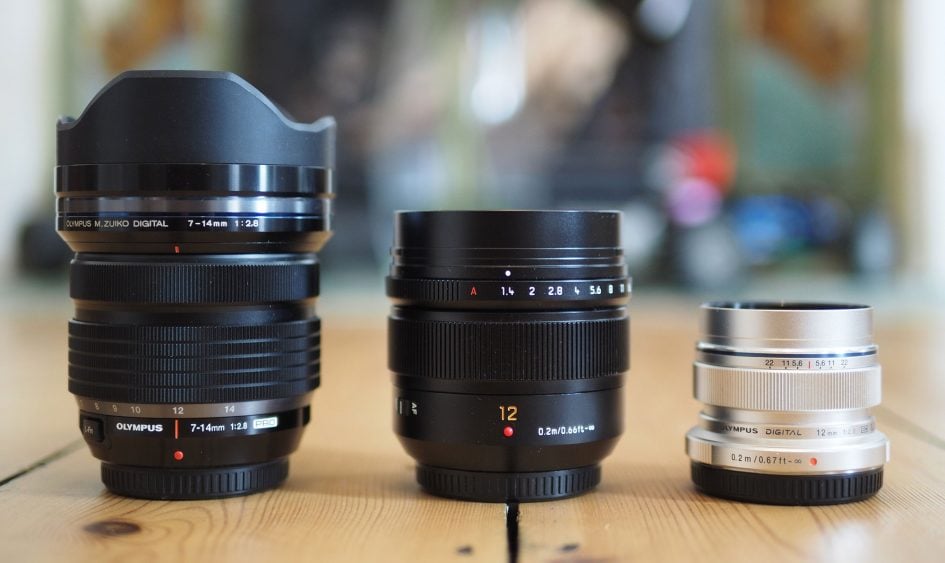
That said, the Summilux 12mm f1.4 is comfortably smaller than the Olympus 7-14mm f2.8 zoom which measures 79mm in diameter (no option to mount filters without a third-party adapter), 106mm in length and weighs 534g.
In terms of build quality, the Summilux 12mm f1.4 feels solid and robust, with its metal body boasting dust and splash-proof construction; note my sample didn’t have a rubber sealing on the lens mount though, so I’m not sure how resistant it would be at this join. The Olympus 12mm f2 isn’t weather-sealed, although as a PRO lens, the 7-14mm f2.8 does enjoy environmental sealing.
Like other Leica Summilux collaborations, the manual focusing ring feels very smooth and nicely damped, especially compared to the little Olympus primes who’s focusing rings can come across as a little loose and scratchy in comparison. That said, the Olympus 12mm f2, like the 17mm f1.8 and 7-14mm f2.8, features a manual focusing ring that can be pulled-back down the barrel a little to reveal a focusing distance scale. When pulled-back, these lenses offer direct and more tactile adjustment of manual focus. I should also add the zoom and focusing ring on the Olympus 7-14mm f2.8 also feel smooth and well-damped – it’s just the small Olympus primes which sometimes fall behind in this regard, especially after extensive use.
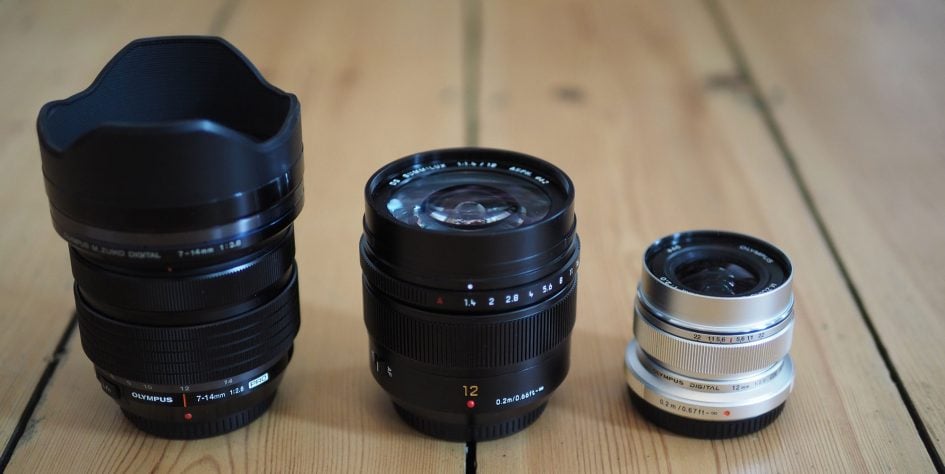
The focusing motor is compatible with bodies that support 240fps lens-drive and in my tests it certainly focused quickly and quietly on the bodies I tested it with. But I should note it was no faster or quieter than the Olympus 12mm f2 for stills photography. I hope to perform more tests for movie AF as this could be an advantage of the Summilux 12mm on certain Lumix bodies.
Like the Summilux 15mm f1.7 and Nocticron 42.5mm f1.2, the Summilux 12mm f1.4 features an aperture ring towards the front of the barrel, labeled with the classic Leica font. The aperture range of f1.4 to f16 can be manually selected with the ring in one-third increments when mounted on Panasonic Lumix G bodies, or set to A for electronic control by the camera. If you mount it on an Olympus body, the ring’s position is completely ignored and the aperture control becomes fully operated by the body.
As noted earlier the Summilux has a fairly wide 62mm filter thread, considerably larger than the 46mm on the Olympus 12mm prime. Leica supplies a circular lens hood of a constant depth which once mounted protrudes about 14mm from the end of the barrel – modest protection against glare, but I did appreciate the physical protection from potential knocks and kept it fitted at all times.
Leica Summilux 12mm f1.4 optical construction
The Leica Summilux 12mm f1.4 employs 15 elements in 12 groups, including two aspherical lenses and two UED (Ultra Extra-Low Dispersion) lenses, along with a nine-blade aperture. This makes it much more complex than the 11 element / 8 group / seven blade design of the Olympus 12mm f2.
The two-times field-reduction of Micro Four Thirds means the lens delivers a 24mm equivalent field-of-view that’s one of my favourites of all lenses. Noticeably wider than plain-old 28mm with more exciting perspective, but without the extreme coverage of 20mm or ultra-wides. Here’s how it looks on my usual Brighton test location, and don’t worry, you’re not going mad, the ferris wheel attraction has been taken down.

Above: Leica Summilux 12mm f1.4 on Lumix GX80 / GX85 at f2.8, 1/6400, 200 ISO
I also shot from this location with the Olympus 12mm f2 for my quality comparison and as a side-note, found them delivering essentially the same actual coverage – something that’s shouldn’t be taken for granted even when two lenses quote the same focal length.
The big optical difference between the Summilux 12mm and its various rivals is of course the focal ratio which, at f1.4, is the brightest 24mm equivalent lens for the Micro Four Thirds system. The Olympus 12mm f2 and Samyang 12mm f2 are both one stop slower, meaning they’ll need a one stop slower shutter or one stop higher ISO under the same conditions. This gap broadens with the Olympus 7-14mm f2.8 which is two stops slower and the Lumix G 7-14mm f4 which is three stops slower. Note none of these lenses offers optical stabilisation, so you’ll need a body with built-in stabilisation to iron-out any wobbles and extend the slowest shutter for handheld work. I used it on the Panasonic Lumix GX80 / GX85 and Olympus OMD EM1 and found I could exploit their body-based IS to handhold at shutters of half a second or sometimes slower still.
Bright lenses really come into their own when shooting video, where there is a minimum shutter speed for normal use. As such in low light, it’s about balancing the ISO against the maximum aperture and with f1.4 at your disposal, you’ll be able to film at sensitivities one stop slower than the f2 lenses, two stops slower than the f2.8 lenses and three stops slower than the f4 lenses. This can make a big difference to quality.
Bright apertures are also valuable to both stills and movie shooters for achieving shallow depth-of-field effects and even though 12mm / 24mm equivalent is a fairly wide lens with an inherently larger depth-of-field than longer lenses, it is still quite possible to enjoy some blurring. I wanted to see how the blurring compared in degree and quality against the Olympus 12mm f2 and Olympus 7-14mm f2.8 set to 12mm, so shot a subject close to the minimum focusing distance with some fairly lights in the background. Here’s the full scene, followed by crops from the upper right corner from each lens at their maximum aperture (for starters!).
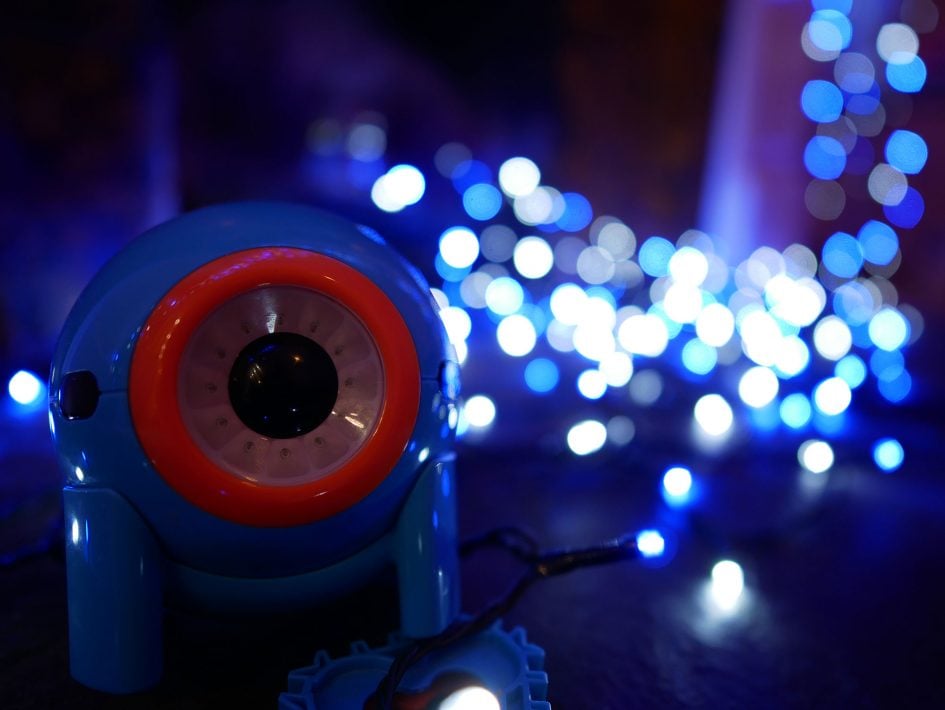
Above: Leica Summilux 12mm f1.4 on Lumix GX80 / GX85 at f1.4, 1/60, 200 ISO
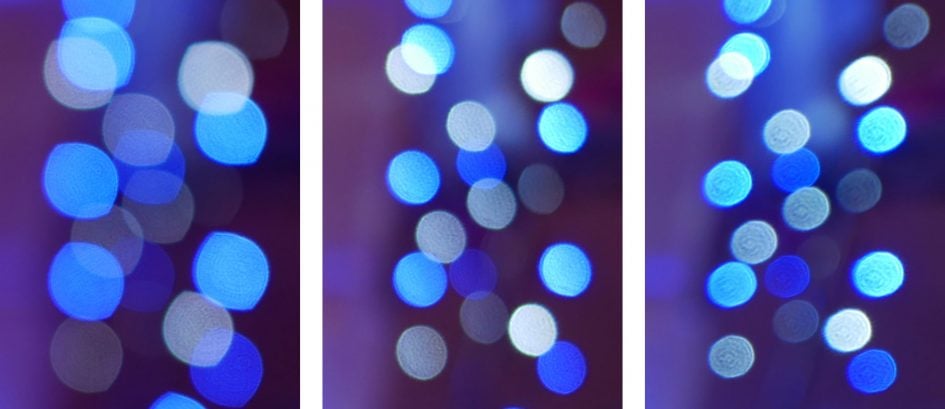
Above: bokeh crop. Leica 12mm at f1.4 (left), Olympus 12mm at f2 (middle) and Olympus 7-14mm at 12mm f2.8 (right)
As you’d expect, when each lens is set to its maximum aperture, the Summilux 12mm f1.4 is delivering the shallowest depth-of-field with the largest bokeh blobs. They’re noticeably larger than those from the Olympus 12mm at f2, although the Olympus 7-14mm isn’t too far behind its f2 counterpart even at f2.8. You’ll also notice both primes are rendering the cats-eye squashed oval shape at their maximum apertures, but from f2.8 onwards all three lenses are showing a shape closer to that of the actual LED bulbs in the fairy lights. Remember these lights are not perfect point sources of light, which is why you’re not seeing perfectly oval or circular blobs.
Now here’s a sequence comparing the same apertures side-by-side, so clearly the Summilux is shown in isolation, joined by the Olympus prime at f2, then all three from f2.8 onwards. While all three lenses begin to show more of the non-circular shape of the lights as their apertures are gradually closed, you’ll notice the Summilux maintains slightly larger blobs despite the same focusing distance. You’ll also notice the impact of the aperture blades as each lens is closed, revealing a nine-sided shape for the Summilux and seven-sided shapes for the two Olympus lenses.
I admit the LED lamp shape proved less than ideal for this comparison, so hope to make some alternative comparisons with more circular and or distant lights in the future. I hope this initial comparison still provides a useful flavour of the lens’ rendering characteristics though.

Above: bokeh crop. Left: Leica 12mm at f1.4
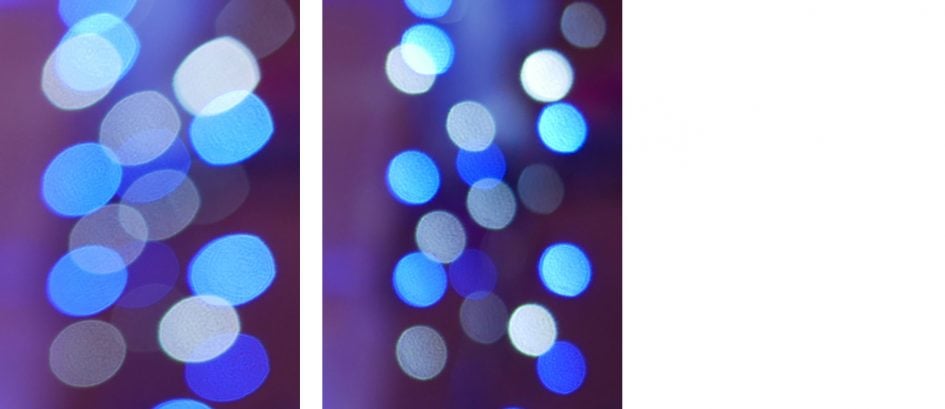
Above: bokeh crops. Left: Leica 12mm, middle: Olympus 12mm, both at f2
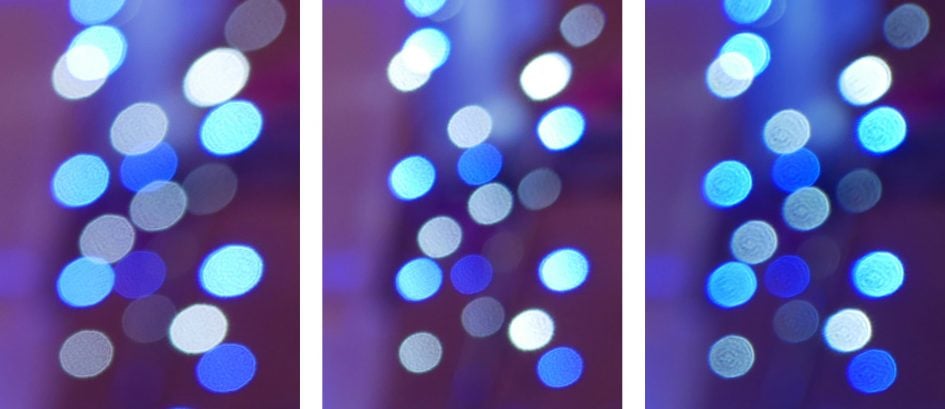
Above: bokeh crops. Left: Leica 12mm, middle: Olympus 12mm, right: Olympus 7-14mm at 12mm. All at f2.8
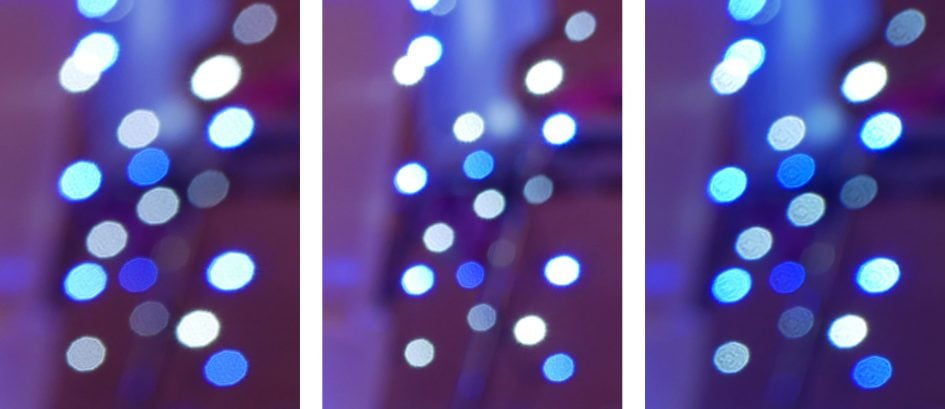
Above: bokeh crops. Left: Leica 12mm, middle: Olympus 12mm, right: Olympus 7-14mm at 12mm. All at f4
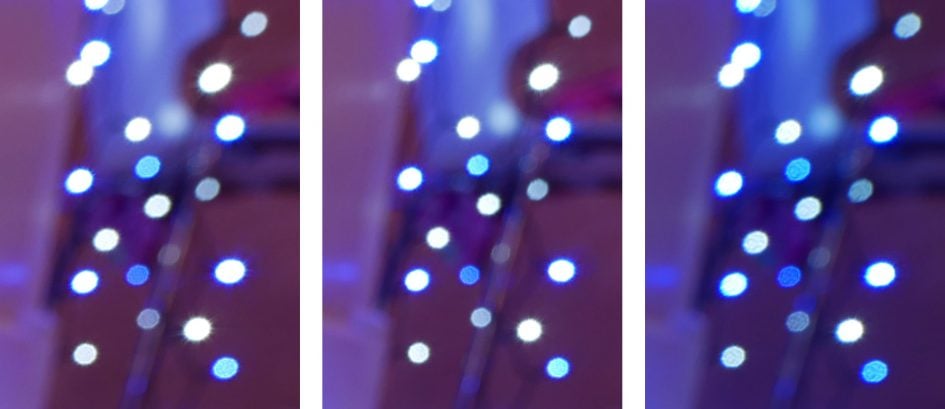
Above: bokeh crops. Left: Leica 12mm, middle: Olympus 12mm, right: Olympus 7-14mm at 12mm. All at f5.6
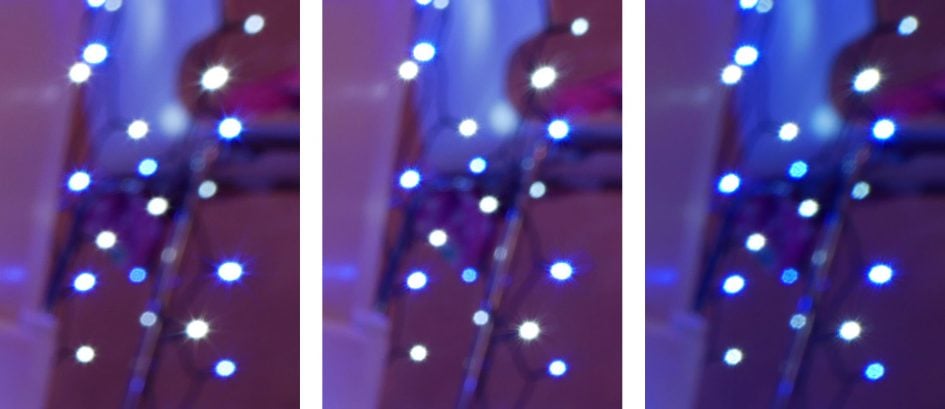
Above: bokeh crops. Left: Leica 12mm, middle: Olympus 12mm, right: Olympus 7-14mm at 12mm. All at f8
Another important specification for a lens is the minimum focusing distance, and interestingly the Leica Summilux 12mm f1.4, Olympus 12mm f2 and Olympus 7-14mm f2.8 all quote the same figure of 20cm. Some reviewers might leave it at that and assume their close-up capabilities were identical, but it’s critical to actually try these things in practice. By simply photographing a ruler as close as I could focus with each lens and still enjoy a sharp image, I found the Summilux could actually get a little closer than the Olympus 12mm prime and enjoy a slightly greater reproduction as a result. As illustrated below, I captured a subject 124mm across the width of the frame using the Summilux compared to 171mm with the Olympus 12mm and 127mm with the Olympus 7-14mm zoom.

Above: closest focusing distance. Left: Leica 12mm, middle: Olympus 12mm, right: Olympus 7-14mm at 12mm
Here are a selection of images showing the Summilux 12mm f1.4 in practice shooting near and far, and in bright or dim conditions.
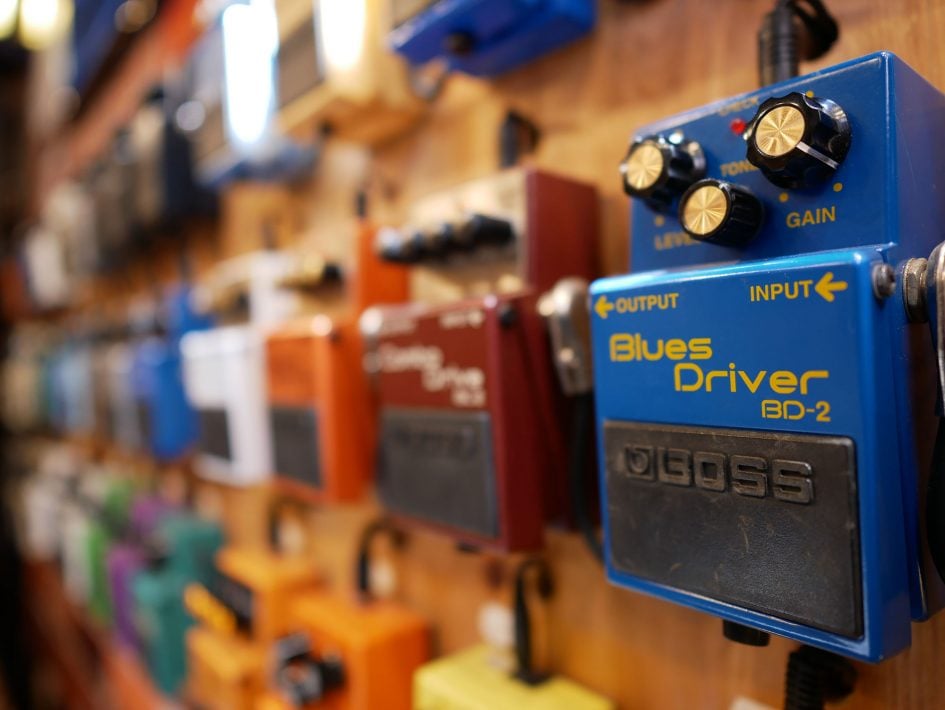
Above: Leica Summilux 12mm f1.4 on Lumix GX80 / GX85 at f1.4, 1/60, 200 ISO

Above: Leica Summilux 12mm f1.4 on Lumix GX80 / GX85 at f1.4, 1/80, 200 ISO

Above: Leica Summilux 12mm f1.4 on Lumix GX80 / GX85 at f1.4, 1/80, 200 ISO

Above: Leica Summilux 12mm f1.4 on Lumix GX80 / GX85 at f1.4, 1/10000, 200 ISO
Finally for this page I’d like to compare the geometric distortion between the three lenses. It can be a challenge to isolate the optical performance on some systems, particularly Micro Four Thirds, as various corrections take place at a low level. But for this comparison I shot a chart at fairly close range using the RAW mode on a Lumix GX80 / GX85 and processed the files in Adobe Camera RAW with all lens corrections disabled. These included distortion correction, although again there could have been additional compensation applied by the body at the RAW level.

Above: geometric distortion. Left: Leica 12mm, middle: Olympus 12mm, right: Olympus 7-14mm at 12mm
From the images above, I’d say the leader is the Olympus 7-14mm f2.8 zoom set to 12mm, although the Leica Summilux 12mm f1.4 isn’t far behind. Both are ahead of the Olympus 12mm f2 which exhibits the most visible distortion here, barreling towards the edges, although it’s still far from the worse I’ve experienced and something that’s easily corrected in post.
Now it’s time to compare the sharpness across the frame with each lens when shooting a distant real-life landscape. See how they compare in my Leica Summilux 12mm f1.4 quality results or skip to my Leica Summilux 12mm f1.4 sample images!
Check prices on the Leica 12mm f1.4 at Amazon, B&H, Adorama, or Wex. Alternatively get yourself a copy of my In Camera book or treat me to a coffee! Thanks!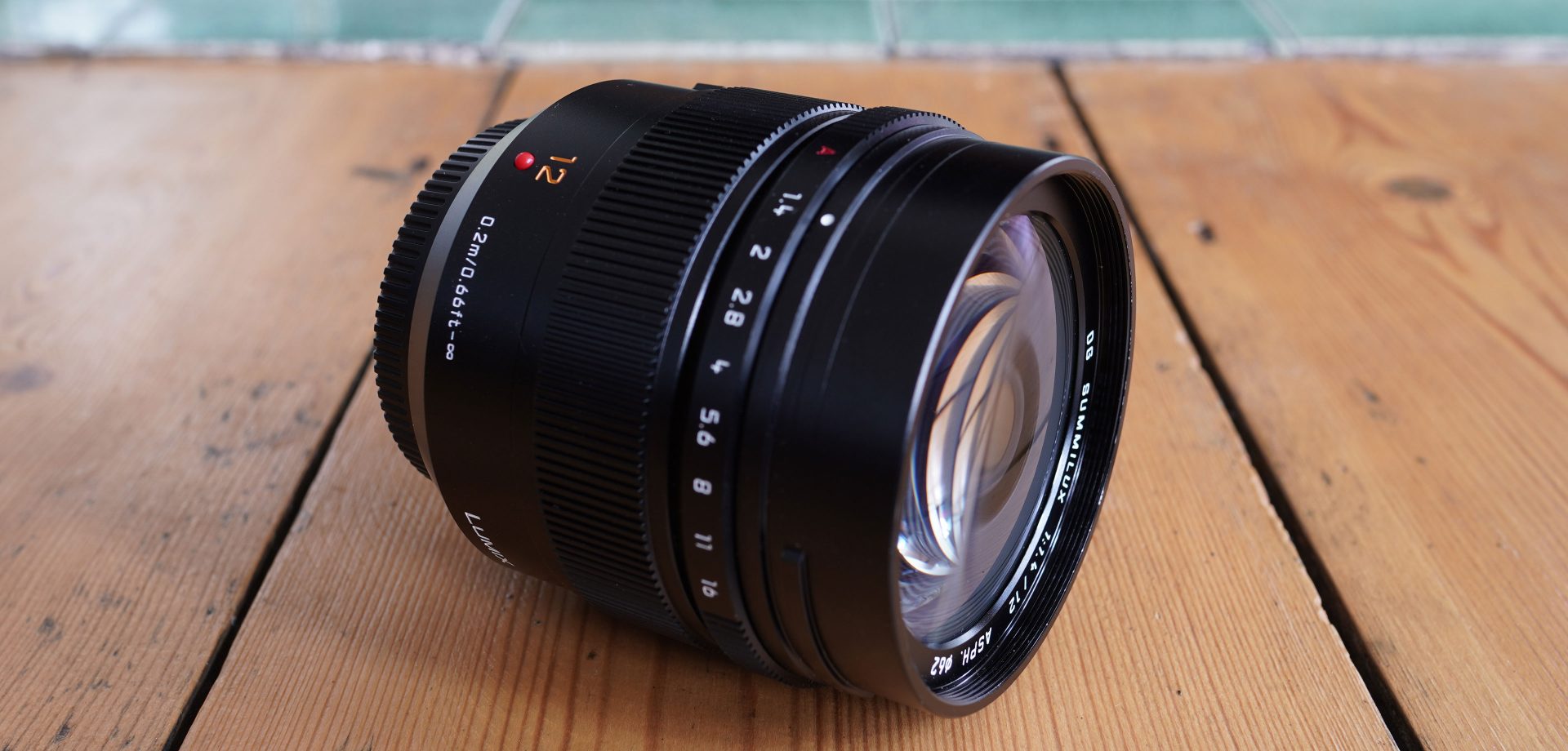
 The Leica Summilux 12mm f1.4 is a high-end lens for Micro Four Thirds bodies on which it delivers the classic 24mm coverage. Olympus and Samyang offer cheaper - not to mention smaller and lighter - 12mm prime lenses, but the Summilux is a stop brighter, sharper in the corners when wide-open and the only one that's dust and splash-proof. It's also comfortably more expensive, costing around double that of the Olympus, so you have to ask yourself if you'll exploit its benefits. Ultimately the Summilux is an unashamedly premium lens that delivers the goods and is a welcome addition to the expansive Micro Four Thirds catalogue.
The Leica Summilux 12mm f1.4 is a high-end lens for Micro Four Thirds bodies on which it delivers the classic 24mm coverage. Olympus and Samyang offer cheaper - not to mention smaller and lighter - 12mm prime lenses, but the Summilux is a stop brighter, sharper in the corners when wide-open and the only one that's dust and splash-proof. It's also comfortably more expensive, costing around double that of the Olympus, so you have to ask yourself if you'll exploit its benefits. Ultimately the Summilux is an unashamedly premium lens that delivers the goods and is a welcome addition to the expansive Micro Four Thirds catalogue.



